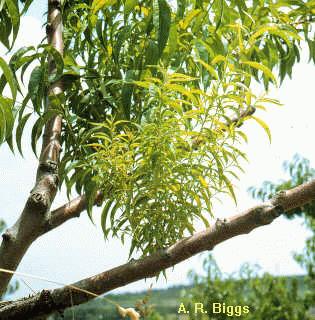 Mid-Atlantic Stone Fruit
Mid-Atlantic Stone Fruit
Background of Disease: Peach yellows is a disease caused
by a phytoplasma (formerly called mycoplasma-like object (MLO)),
a group of organisms similar to viruses, but with
characteristics of bacteria as well. It is endemic to the
eastern U.S. It may become a problem in peach blocks in years
when trees are not sprayed (as in years of crop loss following
freeze injury). The natural host of the disease is wild plum,
which is asymptomatic. This is also the main host of the
leafhopper vector. When trees are not sprayed, some leafhoppers
will move to peach, although this is not a preferred host.
Unfortunately, while the natural host is asymptomatic, peach is
susceptible to expression of the disease of peach yellows. Also
vulnerable are nectarine, apricot and Japanese plum. The disease
may be transmitted by leafhoppers, also by grafting and budding,
and by seed. It is not spread by mechanical means such as
pruning. Peach yellows was a major factor in the decline of the
peach industry in Delaware between 1890 and 1900. This disease
is a quarantine issue in California, Washington State and
Oregon. There is a similar disease in Europe.
Symptoms: Symptoms include witches' broom growth (see
photo above, courtesy of West Virginia University) and premature
ripening of fruit. While fruit develop color early and are
large, taste is bitter and quality is inferior. Leaves also
unfold earlier than normal. Expression may be confined to one
limb, on all limbs except one, or the whole tree. Infected buds
may not become fully dormant, and consequently limb tissue may
die.
Role of leafhoppers: The insect vector is plum leafhopper, Macropsis
trimaculata (Fitch). Kunkel (1933) tested several insects
and found this was the only species capable of transmitting the
disease. Hartzell (1935) reported that 47 other insect species
were tested and found not capable of transmission, including
green peach aphid, Myzus persicae, black peach aphid, Brachycaudus
persicae (Passerini), several leafhoppers (Graphocephala
coccinae Forst., Jassus olitorius Say, Erythroneura
obliqua Say, Empoa rosae L., Eutettix strobi
Fitch, Empoasca fabae Harris (potato leafhopper), Empoasca
sp., Cicadula sexnotata Fall., and Agallia
sanguinolenta Prov.), tarnished plant bug and several
other mirids, unidentified psyllids, Thrips tabaci and Heliothrips
femoralis Reuter, twospotted spider mite and several other
mites, plum curculio and peachtree borer. Black peach aphid was
once thought to be the cause of the disease, because its
geographical range is similar to that of the disease.
Plum leafhopper has a singe generation annually. It is most
common on plum, Prunus americana, and much more rarely
on peach and a few other Prunus species. It is found in
eastern North America from Quebec and Ontario to Virginia,
westward to Ohio, Illinois and Indiana. The range of wild plum
extends much farther southward, but peach yellows is present
only as far south as the range of plum leafhopper.
Adult plum leafhoppers are dull reddish-brown with indistinct
markings. The linked images show the color and rough shape (plum
leafhopper top, side and front
views; this specimen was collected in 1919 in Vienna, Virginia,
and is missing its front wings). Females are larger than males,
with a length of 5 mm compared with 4.5 for males. Eggs are laid
beneath the bark of plum; this is the overwintering stage. Eggs
hatch as plant tissue growth starts in spring. Since nymphs
cannot fly, they develop on the overwintering host. The nymphal
stage lasts about a month. Adults appeared in mid June in New
York, but did not mate until mid July. Adults continue to appear
until July, and are present until mid August. Adults and nymphs
feed on twigs, and hide behind the twig when approached. Their
hiding behavior, combined with a color similar to peach twig
bark, make this insect difficult to detect under normal
circumstances.
Hartzell (1935) presented the seasonal
age distribution of plum leafhopper. The peak of nymphal
populations was in late May - early June in New York. Peak adult
numbers were found in the last week of June. Since peach trees
are vulnerable when poorly sprayed, it might be advantageous to
spray peach trees in late May even in years of crop loss. This
would coincide with the arrival of adults originating on the
preferred native host, wild plum.
References
| Virginia Stone Fruit Page | Peach IPM Page | Virginia Fruit Homepage |
|---|